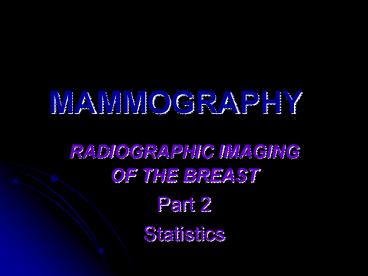MAMMOGRAPHY - PowerPoint PPT Presentation
1 / 32
Title: MAMMOGRAPHY
1
MAMMOGRAPHY
- RADIOGRAPHIC IMAGING OF THE BREAST
- Part 2
- Statistics
2
- A mammogram can find breast cancer when it is
very small -- 2 to 3 years before you can feel
it. - No screening tool is 100 effective. Good quality
mammograms can find 85-90 of cancers
3
Regular breast screening can find cancer when it
is small which means
- there is a better chance of treating the cancer
successfully - it is less likely to spread
- there may be more treatment options
4
MAMMOGRAM
- REMAINS THE SINGLE MOST SENSITIVE TECHNIQUE IN
DETECTION OF BREAST CANCER (ACR) - OTHER MODALITIES
- ULTRASOUND
- MRI
- OTHER - thermography
5
PATIENT FEARS
- PAINFUL
- FIND SOMETHING
- WRONG / DENIAL
- UNINFORMED
- causes cancer
6
RISK FACTORS
- SEX 99 WOMEN
- 1 MEN
- AGE INCREASE WITH AGE
- YOUNGER WOMEN- FASTER GROWING CELLS
7
MORE RISK FACTORS
- HISTORY
- PREGNANCY ABORTIONS
- OBESTIY
- EARLY MENSES
- LATE MENOPAUSE
8
ACS GUIDLINES
- women age 40 to 49 have a routine screening
mammogram - every one to two years
- with the first one beginning at age 40
- BASELINE - for comparison
9
EDUCATION
- BSE breast self exam -MONTHLY
- CBE clinical breast exam
- 3-6 months
- MAMMOGRAM ANUALLY BEGIN AGE 35
10
Best Time For BSE
- The American Cancer Society urges women to
perform breast self-examination (BSE) once a
month - about a week after the menstrual period
- Post-menopausal women should choose a set day,
such as the first of the month, to practice
self-examination.
11
(No Transcript)
12
- Begin by looking at your breasts in the mirror
with your shoulders straight and your arms on
your hips. - Here's what you should look for
- Breasts that are their usual size, shape, and
color. - Breasts that are evenly shaped without visible
distortion or swelling. - If you see any of the following changes, bring
them to your doctor's attention - Dimpling, puckering, or bulging of the skin.
- A nipple that has changed position or become
inverted (pushed inward instead of sticking out).
- Redness, soreness, rash, or swelling.
13
(No Transcript)
14
(No Transcript)
15
Some cancers are not found until they reach this
size A mammogram can find
cancer when it is only this size
16
(No Transcript)
17
(No Transcript)
18
(No Transcript)
19
Cancer statistics
- Breast cancer strikes about 180,000 American
women yearly - and kills about 44,000
- Next to skin cancer, breast cancer is the most
frequently diagnosed cancer in women in the
United States - It is second only to lung cancer in
cancer-related deaths
20
RISK
- "Lifetime risk is the likelihood that a newborn
girl will develop breast cancer sometime during
her entire life. - The 1-in-9 statistic does not apply to women of
all ages
21
RISK VS REALITY chance of being diagnosed with
breast cancer
- 30-year-old woman has a 2 (1 in 50) in the next
20 years - a 40-year-old has a 4.5 (1 in 20)
- 50-year-old woman's risk of developing invasive
breast cancer--the most serious kind--in the next
5 to 20 years - ranged anywhere from 1 in 15 to 1 in 133
depending on her ethnicity.
22
four major ethnic group
- Asian/Pacific Islanders
- Hispanic
- African American
- Caucasian
23
"For women currently aged 50the estimated risk
of developing invasive breast cancer within 5
years
- 0.8 (1 in 133) among Hispanics
- 1.3 (1 in 75) among Caucasians
- Within the next 20 years
- 3.7 (1 in 27) among Hispanics
- 6.6 (1 in 15) among Caucasians
- 5 (1 in 20) among African Americans
- 3.9 (1 in 26) among Asian/Pacific Islanders
24
TYPES OF BREAST TISSUE
25
(No Transcript)
26
(No Transcript)
27
FIBROGLADULAR (DENSE)
- 15 30 YO
- NO CHILDREN OVER 30
- PREGNANT/LACTATING
- UNDER 25 ULTRSOUND RECOMMENDED
28
19-year-old woman who has never been pregnant.
Note the dense glandular tissues with small
amounts of fat
29
FIBRO-FATTY
- AVERAGE DENSITY
- 50 FATTY 50 GLANDULAR
- 30 50 YRS OLD
- YOUNG WOMEN W/ 3 PREGNANCIES
30
(No Transcript)
31
FATTY
- MINIMAL DENSITY FATTY
- OVER 50 YRS OLD
- POSTMENOPAUSAL ATROPHIC
- MALE BREAST
- CHILD BREAST
32
68-year-old woman. Most of the glandular tissue
is atrophic































